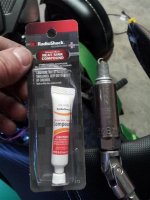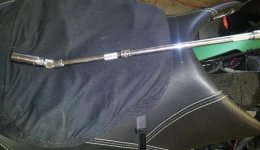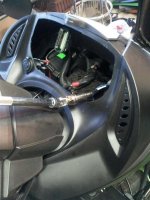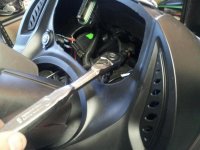-
There were many reasons for the change of the site software, the biggest was security. The age of the old software also meant no server updates for certain programs. There are many benefits to the new software, one of the biggest is the mobile functionality. Ill fix up some stuff in the coming days, we'll also try to get some of the old addons back or the data imported back into the site like the garage. To create a thread or to reply with a post is basically the same as it was in the prior software. The default style of the site is light colored, but i temporarily added a darker colored style, to change you can find a link at the bottom of the site.
You are using an out of date browser. It may not display this or other websites correctly.
You should upgrade or use an alternative browser.
You should upgrade or use an alternative browser.
Spark plugs
- Thread starter SllimG
- Start date
Stupid question. Just changed my spark plugs and the ones I pulled out had white paste on the threads. What is it (dielectric grease maybe?).... Do I need to do this to the new PLUGS? Never seen plugs with this stuff on the before.
That is a silicon paste that brp uses. It is a heat sink paste made by Wacher Silicones. purchased thru brp.
never install plugs with out it.
Last edited:
Silicon possibly create a good seal. BRP will not use it without purpose.
It's a heat sink compound, It transfers heat better between the plugs and cylinder heads.
You can get it at Radio Shack # 276-1372- A. Only 2 or 3 dollars for a small that will last for years.
NancysToy
Motorbike Professor
:agree: Don't neglect to use it...your plugs will have a much shorter lifespan without it. Also be sure to use a little coating of boot release (dielectric grease) inside the spark plug boots, so they don't stick too hard to the plugs and so your plug wires will not be damaged taking them off.It's a heat sink compound, It transfers heat better between the plugs and cylinder heads.
You can get it at Radio Shack # 276-1372- A. Only 2 or 3 dollars for a small that will last for years.
Last edited:
BajaRon
Well-known member
Thermal Heat Sink compound is correct (same thing as used on computer CPU's). Some people think it is anti-seize, DO NOT use anti-seize! Anti-seize is an insulator and does exactly the opposite of what is needed, which is enhanced heat transfer from plug to head (as already mentioned).
The reason for this is the spark plug has a certain heat range (how much heat is retained by the center electrode and porcelain part of the spark plug inside of the cylinder head). Too hot and you get premature ignition (knock) and shortened spark plug life. Too cold and you get a build of of contaminants which can foul the plug.
For this optimum spark plug temperature to be maintained there must be a good pathway to shed heat. Thermal transfer between the spark plug threads and the head is how this is done.

If no thermal paste (or worse, anti-seize) are used you are effectively increasing the heat range and the plug will overheat.
A spark plug that retains too much heat may ignite the incoming fuel charge before any spark is introduced (pre-ignition or knock). The anti-knock sensors detect this condition and begin to retard ignition. While this corrects the problem your engine is not running as it should.
So, use the correct heat range spark plug (RS and RT take different heat range plugs), use a small amount of thermal paste on the spark plug threads, and put dielectric grease on the spark plug boots to keep them from vulcanizing to the porcelain tower.
The reason for this is the spark plug has a certain heat range (how much heat is retained by the center electrode and porcelain part of the spark plug inside of the cylinder head). Too hot and you get premature ignition (knock) and shortened spark plug life. Too cold and you get a build of of contaminants which can foul the plug.
For this optimum spark plug temperature to be maintained there must be a good pathway to shed heat. Thermal transfer between the spark plug threads and the head is how this is done.

If no thermal paste (or worse, anti-seize) are used you are effectively increasing the heat range and the plug will overheat.
A spark plug that retains too much heat may ignite the incoming fuel charge before any spark is introduced (pre-ignition or knock). The anti-knock sensors detect this condition and begin to retard ignition. While this corrects the problem your engine is not running as it should.
So, use the correct heat range spark plug (RS and RT take different heat range plugs), use a small amount of thermal paste on the spark plug threads, and put dielectric grease on the spark plug boots to keep them from vulcanizing to the porcelain tower.
Last edited:
SllimG
New member
It is so nice to have a forum like this. The information here is invaluable. I'm sure most of you guys know how to do this, but thought I would post what I learned today in hopes that it makes this easier for someone else.
Ran to Radio shack and picked up the heat sink compound. This is what I got:

I had a tough time getting the front plug out, but finally figured out an easy way.
First, trying to get the ratchet through the jungle of hoses and wires to the plug was very challenging. What I finally did was to go through the top after removing the display. Make sure the plug socket has the rubber boot in it so it holds the sparkplug. You have to use a swivel to get the right angle. This is what I used:

Inserted socket through here:

Straight down to the plug like this:

This worked very well. The plug came right out and the new one went right back in. I had to guide it just a bit with my other hand while I lowered it back down into place. I didn't have to remove the airbox or console, just the side panel and the display on the console.
Hope someone finds this helpful.
Ran to Radio shack and picked up the heat sink compound. This is what I got:

I had a tough time getting the front plug out, but finally figured out an easy way.
First, trying to get the ratchet through the jungle of hoses and wires to the plug was very challenging. What I finally did was to go through the top after removing the display. Make sure the plug socket has the rubber boot in it so it holds the sparkplug. You have to use a swivel to get the right angle. This is what I used:

Inserted socket through here:

Straight down to the plug like this:

This worked very well. The plug came right out and the new one went right back in. I had to guide it just a bit with my other hand while I lowered it back down into place. I didn't have to remove the airbox or console, just the side panel and the display on the console.
Hope someone finds this helpful.
Last edited:
SllimG
New member
It's a heat sink compound, It transfers heat better between the plugs and cylinder heads.
You can get it at Radio Shack # 276-1372- A. Only 2 or 3 dollars for a small that will last for years.
Thanks! saved me from having to order and wait. Ran to Radio Shack and picked some up. I really appreciate the help.
:thumbup:Thanks! saved me from having to order and wait. Ran to Radio Shack and picked some up. I really appreciate the help
.
:thumbup:
JJW SpyderRider
New member
Thermal Heat Sink compound is correct (same thing as used on computer CPU's). Some people think it is anti-seize, DO NOT use anti-seize! Anti-seize is an insulator and does exactly the opposite of what is needed, which is enhanced heat transfer from plug to head (as already mentioned).
The reason for this is the spark plug has a certain heat range (how much heat is retained by the center electrode and porcelain part of the spark plug inside of the cylinder head). Too hot and you get premature ignition (knock) and shortened spark plug life. Too cold and you get a build of of contaminants which can foul the plug.
For this optimum spark plug temperature to be maintained there must be a good pathway to shed heat. Thermal transfer between the spark plug threads and the head is how this is done.

If no thermal paste (or worse, anti-seize) are used you are effectively increasing the heat range and the plug will overheat.
A spark plug that retains too much heat may ignite the incoming fuel charge before any spark is introduced (pre-ignition or knock). The anti-knock sensors detect this condition and begin to retard ignition. While this corrects the problem your engine is not running as it should.
So, use the correct heat range spark plug (RS and RT take different heat range plugs), use a small amount of thermal paste on the spark plug threads, and put dielectric grease on the spark plug boots to keep them from vulcanizing to the porcelain tower.
After buying a new set of plugs from you I went to Advance Auto to get some dialectic grease and the thermal paste. The parts guys tried to convince me to use Anti-Seize, he said that is what he always recommends and uses. I new that was not right and explained to him why. Thanks to posts like this I knew better than follow his advice. :thumbup:
BajaRon
Well-known member
After buying a new set of plugs from you I went to Advance Auto to get some dialectic grease and the thermal paste. The parts guys tried to convince me to use Anti-Seize, he said that is what he always recommends and uses. I new that was not right and explained to him why. Thanks to posts like this I knew better than follow his advice. :thumbup:
Good for you! Sticking to your guns on this one was the right move. After all, it's not Their Spyder!
Don't get me wrong, they meant well. Anti-seize on a spark plug is old school advise and old ideas die hard. I have Googled this issue and there is some very bad advise out there (with the good, of course).
Thermal paste and anti-seize look similar but they are very different compounds. I'm glad you got what you needed.
My Custom Plug and Wire set comes with Dielectric Grease and Thermal Paste. I am going to start including thermal paste for those who purchase just the spark plugs and I have been including dielectric grease for those who purchase just the wire set.
JJW SpyderRider
New member
Good for you! Sticking to your guns on this one was the right move. After all, it's not Their Spyder!
Don't get me wrong, they meant well. Anti-seize on a spark plug is old school advise and old ideas die hard. I have Googled this issue and there is some very bad advise out there (with the good, of course).
Thermal paste and anti-seize look similar but they are very different compounds. I'm glad you got what you needed.
My Custom Plug and Wire set comes with Dielectric Grease and Thermal Paste. I am going to start including thermal paste for those who purchase just the spark plugs and I have been including dielectric grease for those who purchase just the wire set.
Good to know you will include the grease and paste with the new wires. :yes: You can bet I will be ordering my plugs and a new set of wires from you for my new RT when that time comes.
Texmac1011
New member
It is so nice to have a forum like this. The information here is invaluable. I'm sure most of you guys know how to do this, but thought I would post what I learned today in hopes that it makes this easier for someone else.
Ran to Radio shack and picked up the heat sink compound. This is what I got:
View attachment 60050
I had a tough time getting the front plug out, but finally figured out an easy way.
First, trying to get the ratchet through the jungle of hoses and wires to the plug was very challenging. What I finally did was to go through the top after removing the display. Make sure the plug socket has the rubber boot in it so it holds the sparkplug. You have to use a swivel to get the right angle. This is what I used:
View attachment 60047
Inserted socket through here:
View attachment 60048
Straight down to the plug like this:
View attachment 60049
This worked very well. The plug came right out and the new one went right back in. I had to guide it just a bit with my other hand while I lowered it back down into place. I didn't have to remove the airbox or console, just the side panel and the display on the console.
Hope someone finds this helpful.
I will definitely give this a try next time. That airbox causes me more grief.....................
Captain Fin
New member
Thanks for the advice!
I will be changing my plugs soon. Thanks for the great advice and photos.
I will be changing my plugs soon. Thanks for the great advice and photos.
xpeschon
MOgang Member
:agree: Don't neglect to use it...your plugs will have a much shorter lifespan without it. Also be sure to use a little coating of boot release (dielectric greas inside the spark plug boots, so they don't stick too hard to the plugs and so your plug wires will not be damaged taking them off.
Tip of the day about the dielelectric grease,, don't ask!!! Great advice coming from a great person...
X Man
BajaRon
Well-known member
Ron
Will you be able to do the plug/wire install at the fest?
How much would that run? (when quoting pricing, remember I have sold many on your sway bar. Love it! :clap::yes
Thanks
Larry
I will be at Spyderfest. I plan to come as a participant and not as a vendor. Last year Len and crew handled my wire sets. I assume he will do this again but I have not discussed it with him. He's been a tad busy lately!
Since we're talking spark plugs, what is the life span of iridium plugs? My RT came with them & I now have 5000 miles on them, when should I consider changing them?:dontknow:
Thanks,Wayne
The iridium spark plugs should last you at least 30,000 miles. The problem you're most likely to run into is that the wires will not last nearly that long, maybe 15k. Some have gotten more miles, some less out of their OEM wires. But the wires are certainly the weak link.
Similar threads
- Replies
- 8
- Views
- 380
- Replies
- 34
- Views
- 7K
- Replies
- 4
- Views
- 163
- Replies
- 3
- Views
- 230
